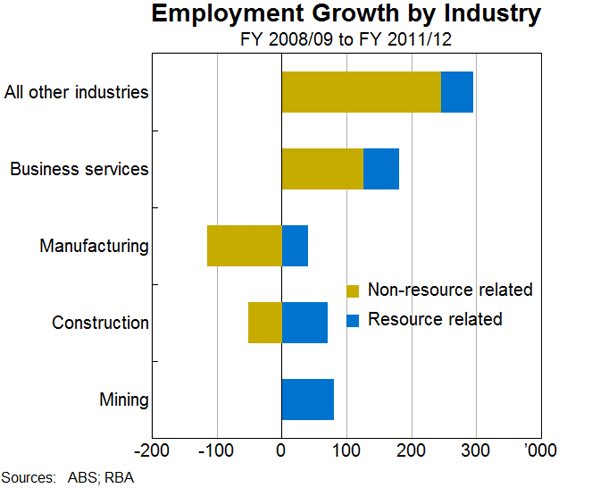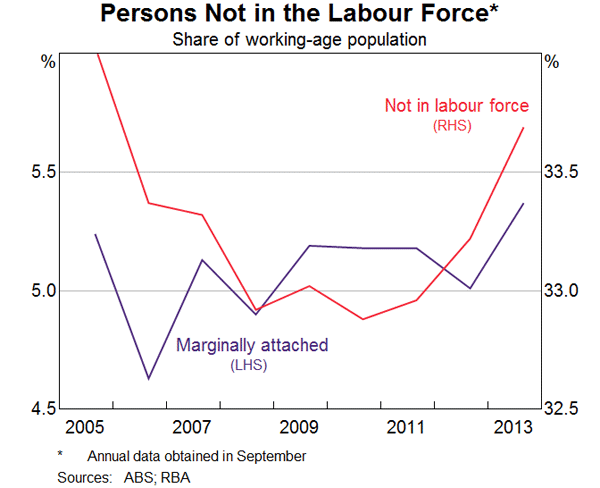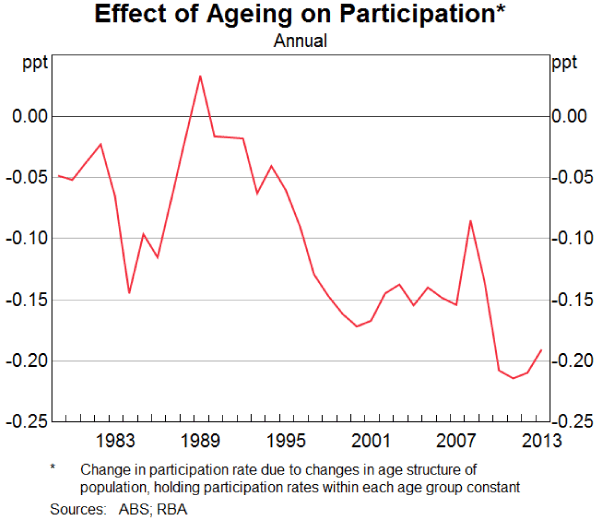The RBA's glass half-full spin is no easy job
According to the Reserve Bank of Australia (RBA), employment growth will gradually pick-up over the next two years. But with our population expanding rapidly that will be of little comfort to many Australians, with a high unemployment rate set to persist and wage growth to remain at low levels.
RBA assistant governor Christopher Kent delivered a speech on labour market developments today which outlined some of the structural and cyclical drivers of the Australian labour market.
Of the cyclical factors -- by which I refer to factors driven by the business cycle -- the most important has been Australia’s transition from the relatively labour-intensive production phase of the mining boom towards the more capital-intensive production stage.
The graph below highlights the contribution of the mining sector to employment growth -- not just directly but also indirectly though sectors that have benefited via the mining boom. From 2008-09 to 2011-12, resource-related activity accounted for more than half of the growth in employment. As that process unwinds and transitions we have seen a sharp fall in employment by business services, with much of slack filled up by household services.

To some extent our labour market continues to be hampered by a simply lack of opportunity. This is most obvious in the rising number of discouraged workers who have given up on finding a job; this group is also known as those with a marginal attachment to the labour market.
This is fairly common when an economy is growing at a below trend pace. Nevertheless it has some important implications, particularly since those with a marginal attachment to the workforce are often the long-term unemployed who struggle to get back into the work force when conditions improve.

Structurally the Australian labour market continues to be affected by an ageing population, which continues to weigh on the labour force participation rate. The graph below shows how significant this effect has been but also highlights that it has been an ongoing issue for over a decade. However, this was largely masked until recently by rising participation for those over the age of 55 -- particularly among women.

It is worth bearing in mind that the effect is cumulative -- so an ageing population is pushing the participation rate down by around 0.2 percentage points annually. Over five years that will result in the participation rate declining by around 1 percentage points.
In the long-run this effect will be partially offset by rising participation among older Australians, particularly once the retirement age begins to rise. But that isn’t for some time and in the meantime we live in an economy that is leaving the heavy lifting to an increasingly small share of the population.
Then there are cyclical factors which could eventually become structural. A good example is the increasing share of young Australians who are not studying and haven’t been employed for over a year. A lack of opportunity for younger Australians has created the risk of skill atrophy and declining levels of institutional knowledge as less experienced workers replace older Australians. So far this is an issue that has largely been ignored by our state and federal governments.
Finally, Kent took the opportunity to discuss wage growth. In recent quarters, real wage growth has turned negative with inflation rising at a faster pace than wages across the country. I’ve framed this as a concern for household spending -- and it undoubtedly is -- but the RBA has attempted to put a glass half-full spin on the topic.
Kent notes that a more flexible labour market, compared with earlier terms-of-trade booms, has been helpful. This has effectively slowed growth in total labour costs and aided Australia’s international competitiveness -- which will only be helped further as Australia’s exchange rate declines further.
An internal devaluation -- as opposed to devaluing our exchange rate -- is important given that the exchange rate is unlikely to fall sufficiently to completely meet the needs of the non-mining sector. Given the continued strength in exports, and still somewhat elevated foreign investment, it would be surprising if the Australian dollar fell to a level that would enable our manufacturing sector to rebound.
Certainly if wage growth had continued at its long-term average there would have been greater unemployment but that’s hardly a comfort for the millions of Australians who have seen their purchasing power decline over the past year. Nor is it much comfort for Australian retailers.
The Australian labour market faces a range of near-term and long-term challenges which has created a significant amount of uncertainty for the Australian economy. The end of the mining boom will weigh on our labour market for some time yet, and certainly an ageing population will do us no favours.
The analysis reinforces how important it is that the Australian dollar drops and does so quickly. That will limit the need for an immediate internal devaluation to boost competitiveness -- though it will still be needed in some sectors -- and also help support our floundering non-mining sector.
















